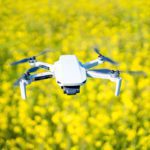
Drones have the potential to help growers save on labor for scouting and pesticide application, lower pesticide volumes because of better targeting, significantly reduced worker exposure to pesticides and reduce soil compaction and erosion.
Though federal guidelines currently limit their size and application, small unmanned aerial systems (UAS) can enhance the safety and efficiency of floriculture growing operations and stand to become essential tools of the trade in the near future.
Smaller drones — mostly vertical-takeoff-and-landing multirotor aircraft — are heavily marketed to the agriculture industry, including floriculture and horticulture operations. They are generally inexpensive and easy to operate while new, smaller sensors and cameras provide significant capability, according to Madison Dixon, research director at Mississippi State University’s Raspet Flight Research Laboratory.
Dixon provided 40 examples of small drones available for commercial use and detailed their applications in floriculture during a March 16 webinar hosted by the Society of American Florists. MSU leads the Federal Aviation Administration’s UAS Center of Excellence and UAS Safety Research Facility and is used by the Department of Homeland Security as a designated drone test site.
“UAS have proven extremely useful for a variety of agricultural and horticultural uses and applications,” Dixon said. “The benefits are there. The benefits, by and large…ultimately come down to safety, operational efficiency and informed decision making.
“If you can implement the technology in your operations and add efficiency and autonomy, that hopefully will reduce your costs at the end of the day,” he added. “Ultimately we want to increase yields and these provide you the means to do that through informed decision making,”
Existing commercial UAS operators vary in their offerings, which range from UAS service providers working in multiple industries, agronomists, other agricultural service companies and major agriculture companies, such as Monsanto, that are developing internal UAS capabilities, Dixon said.
Appropriately configured drones have vast potential on flower farms, where they can disperse pest and disease control agents accurately and in smaller quantities, monitor abiotic stresses, provide mapping and survey data and thermal imaging.
“Drones have the potential to help growers save on labor for scouting and pesticide application, lower pesticide volumes because of better targeting, significantly reduced worker exposure to pesticides and reduce soil compaction and erosion,” said SAF Senior Vice President Katie Butler.
Ariel Scouting
Aerial scouting and photography is the most basic, straightforward application of drones in agriculture.
“Step one, square one is aerial scouting,” Dixon said. “You don’t need any specialty software. All you need to be able to do is safely operate the aircraft and go out and be able to look at your operation and capture photos. These can be used in everyday instances, as well as emergency instances. Say you had a major disaster or weather event come through and you need to document the scope of damage for an insurance claim. There is no better way to do it than .”
Aerial photos of growing operations, events and other floriculture activities are effective marketing tools when posted to social media or used in traditional advertising. On the more complex end of the spectrum, UAS are useful for thermal imaging, vegetation health assessment, wildlife habitat management, environmental monitoring, surveying, mapping and aerial spraying.
Ariel Spraying
Aerial application of pesticides by drones is a fairly new concept that has gained a lot of traction, especially for deploying small volumes of pesticides or fertilizers at lower volumes with increased accuracy, Dixon said. With one gallon of liquid weighing roughly eight pounds and factoring in the weight of an aircraft capable of carrying the payload, Dixon said it is realistic to lift three or four gallons of pesticide, herbicide or fertilizer with a small UAS under current FAA regulations.
“If your operation is a couple tens of acres or even up to 100 or 200 acres or so, small UAS weighing up to 55 pounds can be used for those type of low-volume applications,” he said. “The extent to which that scales with a 55-pound UAS is fairly limited, but the benefits are there.”
Ultimately, unmanned aircraft can minimize waste and the environmental impact of all types of agriculture while reducing field worker exposure to chemicals and lowering operating cost, Dixon said.
Regulations
As effective as UAS can be at improving the safety and efficiency of floriculture operations, marketing campaigns pushing drones on farmers often lead to misinformation about how they can be used and their practical applications, Dixon said.
UAS often are not “plug-and-play” solutions. Most require training by professionals with specific expertise in flying drones and operating sensor payloads. The FAA requires drones weighing less than 55 pounds to have an FAA registration number and all UAS operators — both hobbyists and commercial fliers — must have appropriate credentials. The FAA provides free online certification materials to obtain an online exam.
There also are strict limitations on where and when UAS can be flown, regardless of distance from an airport. Air medical helicopters and manned agricultural application aircraft regularly fly below the 400 ceiling where UAS can be flown. Specific training and local knowledge is required to avoid potentially catastrophic collisions with manned aircraft.
“UAS are still an emerging technology, but it is an emerging technology that can benefit a lot of your operations,” Dixon said. “We are working toward a future where machines can operate autonomously and perform functions or tasks that are dull, dirty or dangerous. … If we can use a UAS or another autonomous system to perform those tasks, we’re going to see those benefits.”
The Raspet lab generally operates UAS that weigh more than 55 pounds, though the FAA has not yet published regulations for commercial use of large drones that have longer range and flight endurance. Regulations are only in place for commercial operation of UAS up to 55 pounds. Any drone heavier than 55 pounds must be operated in cooperation with a public entity with FAA authorization.
“For the use of this technology in your operation, the sky is the limit,” Dixon said. “That’s a pun, but it’s very accurate in terms of the technology and what all it can do, depending on the amount of time, effort and budget you are willing to invest incorporating this into your existing workflow.”
For information on UAS regulations and requirements for commercial operation, visit the FAA website at www.faa.gov/uas.
Watch the free webinar on-demand in Career Connection.
Dan Parsons is a contributing writer for the Society of American Florists.


